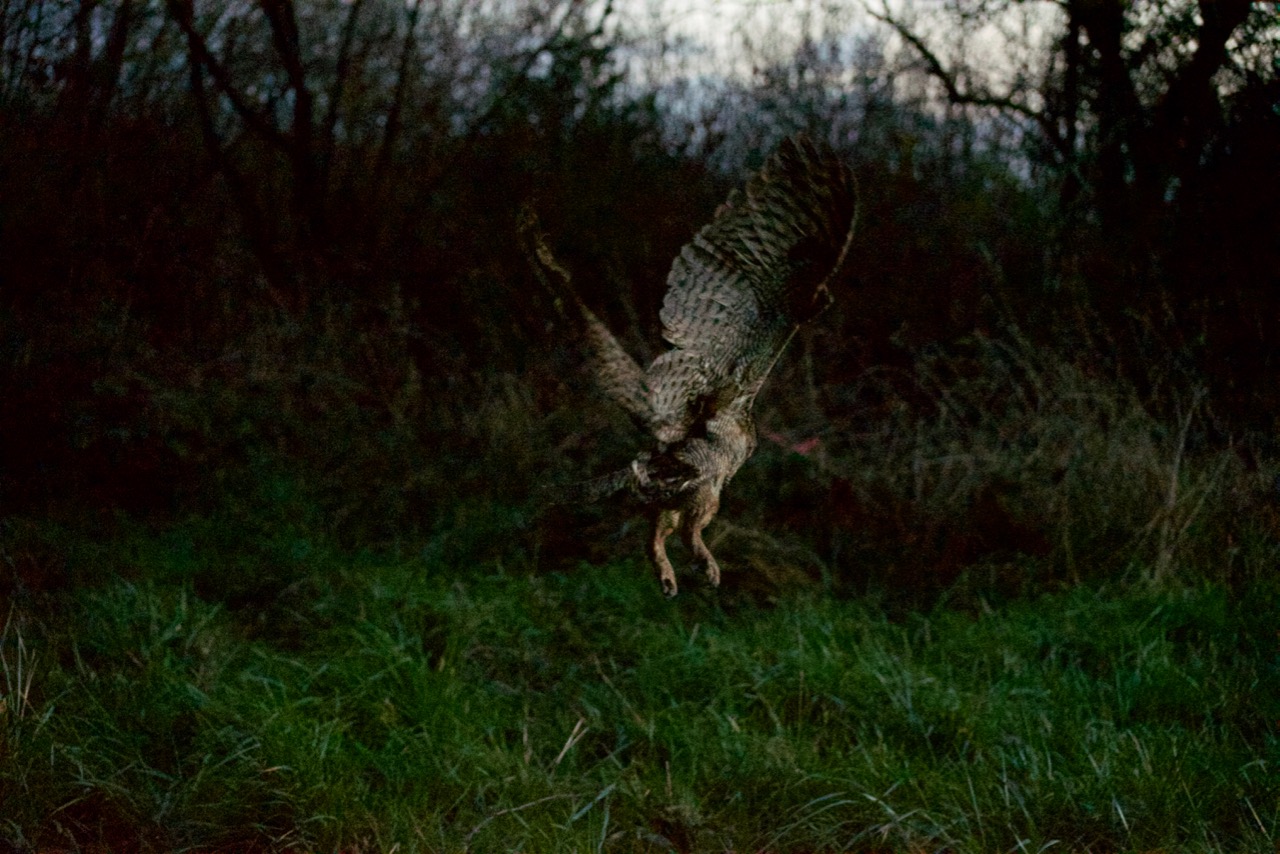
It must have been quite the scene! The people who found this owl inside their duck coop on their property near the stateline with Oregon said that they’d seen the bird harassing one of their ducks. The next day they found her trapped inside the coop, covered in mud, with a recently eaten duck nearby.
How the Great Horned Owl (Bubo virginianus) got in the coop is a mystery. The duck was a big Muscovy, a large breed that would have been a very unusual prey species for a Great Horned Owl. While these are fairly large owls – a typical Muscovy is still nearly twice as big. Catching food isn’t supposed to be a fight to the death.
However the owl got into the coop, the people who found her could tell she needed help. They drove the owl 100 miles south to our clinic, the only permitted all species facility on the North Coast.
During the admission process, we found no obvious injuries – just a frightened, angry, filthy, wet, big female owl.
After a few days of lightly spraying her down with water indoors to help her clean herself, we moved her to an outdoor aviary. Surprisingly, she seemed unable to fly. We hadn’t been expecting that. We took another look at her wings, her shoulders, all of the parts that allow flight. Again, we found no injuries. Since it seemed that she likely was suffering from a strain or sprain, we took her back to the aviary. Time, as it often is, would be the best medicine.
 Our raptor aviary (Merry Maloney Raptor House) is small compared to wide open world but it is big enough that we can assess the flight capabilities of large birds, like this Great Horned Owl.
Our raptor aviary (Merry Maloney Raptor House) is small compared to wide open world but it is big enough that we can assess the flight capabilities of large birds, like this Great Horned Owl.
After a few days of eating and preening, her weight was up and her feathers were in much better shape. At this time she also began making very short flights – nothing spectacular, but enough to know that she was recovering. After a week, she was actually getting from perch to perch. Twelve days after she was admitted, her power returned.

 Catching a flighted patients for her release exam is a critical part of the evaluation. She passed this aspect with flying colors.
Catching a flighted patients for her release exam is a critical part of the evaluation. She passed this aspect with flying colors.
With her flight strong and her health good, it was time to take her home. Although it had been stormy for days we got a long break in the weather mid-week and we improved it with a beautiful owl’s return to her wild freedom.
 Leaving the last of a long series of boxes – some no bigger than a large suitcase, some the size of our aviary, all of them a form of captivity, an insult that ends as soon as the patient has recovered.
Leaving the last of a long series of boxes – some no bigger than a large suitcase, some the size of our aviary, all of them a form of captivity, an insult that ends as soon as the patient has recovered.
 Bird flying away – a heartwarming sight…
Bird flying away – a heartwarming sight…
 After flying away from us, the Owl first stopped in this tree to reconnoiter. This release site was very close to where she had been found so the neighborhood was familiar.
After flying away from us, the Owl first stopped in this tree to reconnoiter. This release site was very close to where she had been found so the neighborhood was familiar.


 After a few minutes, she took off again, into the approaching night.
After a few minutes, she took off again, into the approaching night.

 Our last glimpse before she was gone, slipped into the surrounding Wild.
Our last glimpse before she was gone, slipped into the surrounding Wild.
 A beautiful winter’s night with one more of her family home again…
A beautiful winter’s night with one more of her family home again…
So often we cannot know what happened to injure our wild patients. Context clues, such as where the animal is found, and so forth, along with statistical probabilities are often all we have to go on. Regardless, we still have to treat the animal who shows up, using solid techniques and sometimes our own intuition. It’s highly rewarding work with the only real hazard being that we might fall away from our human neighbors due to how often we must put ourselves imaginatively in the shoes of our wild neighbors. Using our imaginations in concert with good science is the highest level of thought we can achieve when providing care for our patients. This is probably true for most environmental problems that we face.
No matter what methods we use, the one thing that is indispensable is your support. You keep our doors open and our lights on for our wild neighbors in a jam. Thank you!

If you’d like to help, we could use it! Please donate today! Thank you!![]()
all photos: Laura Corsiglia/BAX

